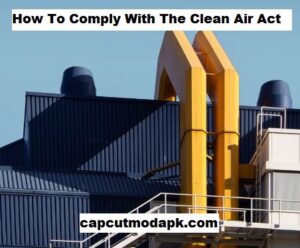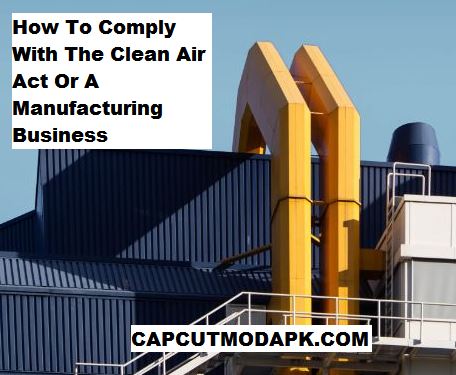How To Comply With The Clean Air Act Or A Manufacturing Business: The Clean Air Act (CAA) is one of the most significant pieces of environmental legislation in the United States, ensuring the protection and preservation of air quality. For manufacturing businesses, understanding how to comply with the Clean Air Act is crucial to both environmental responsibility and regulatory adherence. Non-compliance can lead to heavy fines, legal actions, and reputational damage, making it essential for companies to stay up to date with its regulations.
In simple terms, the Clean Air Act aims to reduce air pollution, safeguard public health, and improve air quality across the country. For manufacturers, this means implementing measures to limit emissions of harmful substances such as sulfur dioxide, carbon monoxide, and particulate matter. Knowing how to comply with the Clean Air Act not only helps in avoiding penalties but also fosters a sustainable and socially responsible business model.
This article explores how to comply with the Clean Air Act for a manufacturing business. It will guide you through the major components of the Act that affect manufacturing operations, steps to ensure compliance, and the potential consequences of failing to meet its standards. Understanding how to comply with the Clean Air Act is essential for maintaining a legally sound business and contributing to the overall health of the environment.
What Is the Clean Air Act?
The Clean Air Act is a comprehensive federal law that regulates air emissions from both stationary and mobile sources. The law, originally passed in 1970 and updated in later years, authorizes the Environmental Protection Agency (EPA) to set and enforce air quality standards. The CAA covers pollutants that harm human health and the environment, including carbon dioxide, particulate matter, nitrogen oxides, and volatile organic compounds (VOCs).
The primary goal of the Clean Air Act is to reduce and control air pollution nationwide. For manufacturers, this means complying with specific standards for air emissions and incorporating measures to minimize their environmental impact. The law divides air quality standards into different categories, including National Ambient Air Quality Standards (NAAQS), New Source Performance Standards (NSPS), and emission standards for hazardous air pollutants (HAPs).
Manufacturers are required to monitor and control the emissions from their operations, ensuring they meet the regulatory limits set by the EPA. This can involve modifying equipment, using pollution control technology, and implementing best practices to reduce emissions. In short, understanding how to comply with the Clean Air Act is not just about following the law but also about adopting environmentally responsible practices that benefit public health and preserve the planet.
What Are the Key Requirements for Manufacturers Under the Clean Air Act?
For manufacturing businesses, compliance with the Clean Air Act requires following a series of regulations and standards. One of the most important aspects of the Act is the need for manufacturers to control their emissions of harmful pollutants. The EPA sets limits for various pollutants, and businesses must ensure their operations do not exceed these limits.
To comply with these limits, businesses must implement air quality management systems that include regular monitoring and reporting of emissions. These systems often involve installing pollution control equipment, such as scrubbers and filters, to reduce emissions at the source. Manufacturers may also be required to apply for permits and provide documentation of their emissions levels.
Another critical requirement is the installation of technology that reduces emissions of hazardous air pollutants (HAPs). Under the CAA, manufacturers must follow specific control measures to limit the release of HAPs, which include substances like benzene, formaldehyde, and mercury. Some manufacturing sectors may be subject to more stringent standards, depending on the type of industry and the pollutants involved.
It’s also important to note that the Clean Air Act requires ongoing monitoring and reporting of emissions. Businesses must regularly report their emissions levels to the EPA or their state environmental agency. This ensures that manufacturers are staying within legal limits and can help avoid penalties or legal consequences.
How To Comply With The Clean Air Act: Steps for Manufacturers
Complying with the Clean Air Act can seem complex, but manufacturers can take a series of straightforward steps to ensure they meet all the legal requirements. Here’s a breakdown of how to comply with the Clean Air Act for your manufacturing business:
1. Understand Applicable Regulations
Manufacturers must first determine which Clean Air Act regulations apply to their operations. This includes identifying the specific pollutants their industry emits and understanding the limits and requirements for controlling those emissions.
2. Obtain the Necessary Permits
Depending on the nature of your operations, you may need to obtain permits from the EPA or your state’s environmental agency. This could involve applying for an air quality permit that outlines the specific emission limits and monitoring requirements for your business.
3. Install Pollution Control Technology
Depending on the type of emissions your facility generates, you may need to install pollution control devices, such as scrubbers, electrostatic precipitators, or activated carbon filters. These systems help reduce harmful emissions and ensure compliance with the Clean Air Act.
4. Implement Emission Monitoring Systems
Manufacturers are required to regularly monitor their emissions and report the data to regulatory agencies. This can be done using continuous emission monitoring systems (CEMS), which track pollutants and provide real-time data to demonstrate compliance.
5. Conduct Regular Audits and Inspections Regular environmental audits and inspections help ensure that your business continues to comply with the Clean Air Act over time. These audits assess your equipment, emissions levels, and the effectiveness of pollution control measures.
6. Stay Updated on Regulatory Changes Environmental regulations are constantly evolving. Manufacturers must stay informed about any updates to the Clean Air Act or state-specific regulations that might affect their business. This will help you maintain compliance and avoid potential violations.
By following these steps and investing in pollution control systems, manufacturers can ensure they comply with the Clean Air Act, avoid fines, and contribute to a healthier environment.
What Are the Consequences of Failing to Comply?
Manufacturers who fail to comply with the Clean Air Act can face severe consequences, including hefty fines, sanctions, and even criminal charges in extreme cases. The EPA has the authority to enforce the law by investigating and taking legal action against businesses that violate air quality standards.
The penalties for non-compliance vary depending on the severity of the violation. For minor infractions, manufacturers may face civil penalties, which can range from several hundred to several thousand dollars per day per violation. For more serious violations, such as intentionally violating emissions limits or falsifying reports, businesses can face criminal penalties, including fines and potential jail time for responsible individuals.
In addition to legal consequences, failing to comply with the Clean Air Act can damage a company’s reputation. Public perception of environmental responsibility is increasingly important, and customers, investors, and stakeholders may choose to distance themselves from companies that fail to prioritize environmental sustainability. This can lead to loss of business, decreased profitability, and a tarnished brand image.
Manufacturers should take compliance with the Clean Air Act seriously, as the long-term consequences of non-compliance can be far-reaching. By proactively following the law and adopting pollution control measures, businesses can avoid legal risks and create a positive impact on the environment.
How To Comply With The Clean Air Act: Best Practices for Manufacturers

Adopting best practices for air quality management can help manufacturers comply with the Clean Air Act and go above and beyond legal requirements. Here are some effective practices:
1. Invest in Cleaner Technology
Many manufacturers are investing in cleaner technologies that not only reduce emissions but also improve efficiency and reduce costs. Energy-efficient machinery, renewable energy sources, and advanced pollution control systems are key examples of how businesses can innovate to meet regulatory requirements.
2. Employee Training
Ensuring that employees are trained in environmental regulations and air quality management is essential for compliance. Employees should be familiar with the importance of pollution control and the steps they can take to minimize emissions in their day-to-day work.
3. Collaborate with Environmental Experts
Working with environmental consultants can help businesses navigate the complexities of the Clean Air Act. Experts can provide guidance on emissions limits, permits, and the most effective pollution control technologies for your operations.
4. Reduce Waste
Waste reduction strategies, such as reusing materials or reducing waste generation, can help minimize emissions and improve a manufacturer’s overall environmental footprint. By cutting down on waste, businesses can reduce their need for costly pollution control measures and further comply with the Clean Air Act.
By integrating these best practices into their operations, manufacturers can not only comply with the Clean Air Act but also become leaders in sustainability within their industry.
Conclusion
Manufacturing businesses play a critical role in maintaining air quality, and understanding how to comply with the Clean Air Act is essential for minimizing environmental impact and avoiding legal risks. Manufacturers can comply by obtaining the necessary permits, installing pollution control technologies, monitoring emissions, and conducting regular audits. Failure to comply with the Clean Air Act can result in significant penalties, damage to reputation, and long-term financial consequences.
By following best practices such as investing in cleaner technologies, providing employee training, and collaborating with environmental experts, manufacturers can ensure they are meeting legal requirements while contributing to environmental sustainability. Staying informed and proactive is key to ensuring long-term compliance with the Clean Air Act, benefiting both businesses and the environment.


